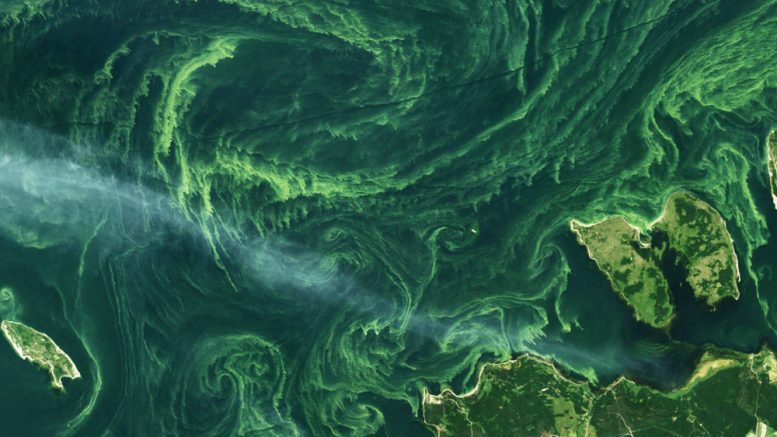When a state of emergency was declared, following a severe outbreak of blue-green algae blooms that appeared in four Florida counties’ aquatic environments, research found that this particular algae is toxic and can cause severe harm to public health.
Research developed at FIU has tackled issues on toxic algae blooms from vast perspectives. According to FIU assistant professor Jose Maria Eirin-Lopez from the Department of Biological Sciences, who is also involved in the Marine Sciences Program, FIU has put an emphasis on research efforts to help understand and combat these issues.
Eirin-Lopez’s research focuses on the effects of natural and human-made marine pollution, including non-toxic algae and blue-green algae on plants and animals. He is a researcher with FIU’s Center for Aquatic Chemistry and the Environment, which collaborates with researchers in the fields of chemistry, ecology, engineering and computing and public health.Their goal is to improve the comprehension of the contamination of the water resources and help build strategies to stop these problems in the environment.
FIU’s research is focusing on understanding the distribution, ecology, and factors motivating the blue-algae blooms. It analyzes toxins produced by these organisms, and studies their harmful effects. It also looks at the mechanisms involved with the responses of marine organisms and humans in contact with algal toxicity.
“This latter topic motivates the most important research line at the environmental epigenetics lab at FIU. In that work, we are trying to determine the identity of the genetic and epigenetic mechanisms involved in the responses of oysters to Florida red tides,” said Eirin-Lopez. “By doing so, we hope to understand a little bit better how organisms cope with the harmful effects of these toxins, but also to identify markers of stress that can be used by the aquaculture industry to identify toxic algal blooms at early stages, thus enabling prevention and supporting management.”
Eirin-Lopez also explained that toxic algal blooms are an issue for three main reasons. The first is that algae blooms cover the water’s surface, and will block light that will exhaust oxygen by harming other plants and organisms that are dependent on this element.
Secondly, the production of toxins, even if it’s an involuntary harm, can affect marine life in contact with the algae.
“For instance, algae will be consumed by herbivores (including turtles and manatees) and invertebrates; these will be consumed by fishes, which will be eaten by other fish, which will be eventually predated by dolphins and sharks,” said Eirin-Lopez. “Biomagnification means that the concentration of toxins at each step increases, therefore impacting top organisms more seriously.”
The third reason why toxic blooms are an issue is the detrimental impact of toxic algae on human health, specifically the liver.
Kathleen Rein, an FIU professor in the Department of Chemistry and Biochemistry, is conducting research focused specifically on algal toxins, and as the director of FIU’s Advanced Research Cooperation in Environmental Health program, she has addressed many issues revolving around algal blooms.
She has identified these species of blue-green algae, the ones blooming in lakes and rivers in Florida, as microcystis aeruginosa. She explains that it can produce a family of toxins called microcystins and the major toxin, called microcystin-LR, can highly affect the liver.
“These toxins affect the liver. Humans get exposed either through contaminated drinking water or through inhalation of aerosols or through recreational use of contaminated water,” said Rein. “The World Health Organization has set of limit of 1 microgram per liter for drinking water. Some municipalities in the U.S. have set lower limits than this. The WHO recommends a limit of ~6-10 ppb for recreational exposure.”
Eirin-Lopez adds that this exposure can lead to gastroenteritis, liver and kidney toxicity as well as several types of neurotoxicity.
Although this particular algae can be harmful to human health, algae in general is a key component of aquatic ecosystems, as they are at the bottom of the trophic chain.
The algae uses sunlight to produce organic matter out of inorganic elements. While under this process, algae begins to produce metabolic byproducts, which, as Eirin-Lopez explains, is mostly harmless.
Different forms of algae can be found throughout South Florida in its diverse aquatic environments such as lakes, the Everglades, the Atlantic Ocean, and the Gulf of Mexico. In addition to being a consistent source of energy from sunlight year round, Eirin-Lopez believes that South Florida represents a perfect haven for these algae to grow free and without limit.
“Harmful algal bloom episodes have always existed and always [will]. However, their current impact and gravity is primarily due to the increased discharge of wastewater in coastal areas. As we cannot influence the amount of sunlight or the natural cycles of the ocean, the only thing we can do is to improve the management of residual waters laden with nutrients,” said Eirin-Lopez.
He also highlights the importance of educating the public and putting policies in place to protect these natural resources.
“ … We must set our eyes in prevention as the best measure to avoid intoxications and optimize aquaculture industry practices. That is the reason why an active stance is required by decision and policy makers, emphasizing the importance of research and outreach, helping alleviate this problem and educating South Florida citizens,” said Eirin-Lopez.






Be the first to comment on "FIU experts discuss health issues caused by toxic algae"